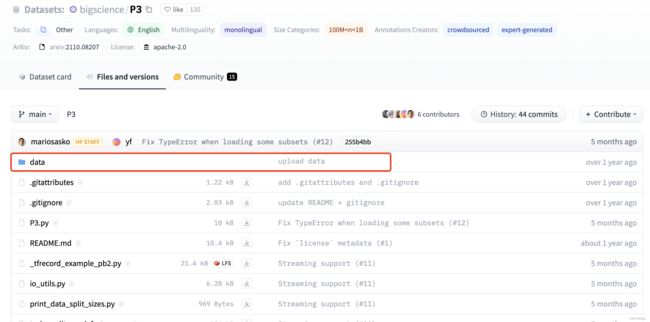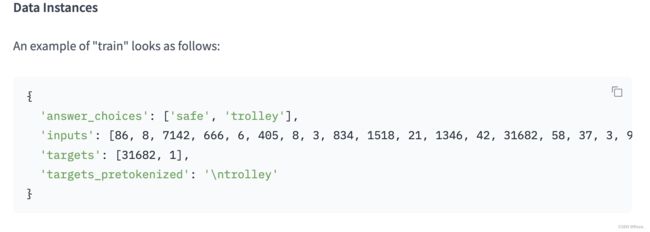下载并处理【T0】指令微调数据集--手把手教程
T0 benchmark(或者叫P3)是一个大规模的人工标注instruction tuning数据集,在ICLR 2021 T0一文中提出,其收集了来自huggingface hub上的多任务数据,并为每一个task都装备了来自prompt source的人工撰写指令。
P3数据集可以在huggingface上找到:链接

然而我们下载之后会发现,所有数据文件都以.tfrecord,而且打开之后的内容非常怪异:

如上图所示,下载的所有数据文件,都是Git LFS 文件(也就是large file system),可以简单理解成pointer,记载了数据所在的存储地址,而真正的数据其实并未下载成功,它们还存储在pointer指向的远端服务器上。
要完全下载P3,需要遵从如下步骤:
1. 下载Git lfs
首先要下载git-lfs, git lfs 官网:https://git-lfs.com/

以mac为例:brew install git-lfs就可以直接安装。
linux的话需要有sudo权限,目前笔者并未找到靠谱的linux上源码安装git-lfs的方法,具体参考:https://askubuntu.com/questions/799341/how-to-install-git-lfs-on-ubuntu-16-04
2. clone仓库
接下来就直接把p3从huggingface hub上克隆下来:
git clone https://huggingface.co/datasets/bigscience/P3
克隆下来之后,会发现整个仓库其实很小,如前面所述,这个时候并未把正真的数据下载,而只是下载了所有LFS文件罢了。
3. 还原LFS文件
接下来先进入P3的根目录,
然后用如下命令,使用git-lfs将所有lfs文件指向的远端文件,都下载下来:
git lfs install # git-lfs initialization, set `--force` if there is any errors
git lfs pull # download all files pointed by lfs
然后就进入了漫长等待。。。整个P3的完整数据应该差不多几百个G大小。。

4.【可选】挑选evaluation subset
由于整个数据集实在太过庞大,所以我们可以选择只下载部分我们需要的数据。
例如,笔者只希望下载T0的 held-out evaluation set(测试集),没有必要把整个庞大的数据集都给下载下来,所以可以先用如下python脚本,将不需要的tasks全部删掉之后再去下载(读者根据自己需要修改代码):
# remain ANLI R1-R3, CB,COPA and RTE tasks
import os
import shutil
def get_directories(path):
directories = []
for entry in os.scandir(path):
if entry.is_dir():
directories.append(entry.name)
return directories
def target_task_dir(directory):
''' only return true when facing with the target task directory. '''
directory = directory.lower()
if "anli" in directory and ("r1" in directory or "r2" in directory or "r3" in directory):
return True
elif "cb" in directory:
# super_glue CB
return True
elif "copa" in directory:
# super_glue COPA
return True
elif "rte" in directory:
# super_glue RTE
return True
else:
return False
path = "./data"
directories = get_directories(path)
for directory in directories:
if not target_task_dir(directory):
# del this directory (including all files in it)
shutil.rmtree(os.path.join(path,directory))
将上述脚本放到P3根目录,python 运行就可以。
删除之后,记得得git保存一下修改:
git add -A
git commit -m "del unused tasks"
之后再去git lfs pull。
5. 处理tfrecord文件
tfrecord是一种专属于tensorflow的二进制文件。虽然我们现在已经下载好了所有数据,但是你会发现这些文件仍然无法直接被编辑器打开,我们也没办法直接查看数据内容。
此时,如果你的代码使用的是tensorflow,那么现在下载好的这些tfrecord文件就可以直接用来构建dataset class,训练模型。除此之外,tfrecord文件相较于其他默认的数据格式类型,不仅节省存储,也能让模型训练、推理也能更高效(详见该博客:https://medium.com/mostly-ai/tensorflow-records-what-they-are-and-how-to-use-them-c46bc4bbb564)。
但如果你用的是其他框架,比方说pytorch;或者用做其他用途,那么我们只能将tfrecord文件再转成其他格式,例如json。
以下步骤用来把T0数据集的所有tfrecord文件转化成json:
5.1 下载tensorflow
数据处理过程类似于逆向工程,所以需要用到tensorflow。
笔者下载了gpu 版本tensorflow,cpu版本应该也可以。具体安装过程自行搜索。
5.2 数据格式转换
首先观察T0数据集目前的文件结构。每一个task folder下都会包含若干文件,其中,两种类型的文件尤为重要:
xxx.tfrecord-00000-of-00001: 数据文件,包含了T0数据集的样本info.xxx.json: 格式文件,定义了对应的tfrecord文件的数据格式结构,例如字段名称、数据类型
所以对于每一个task folder,我们都需要将这个task下的所有xxx.tfrecord-00000-of-00001文件转为json格式,而转换则依赖于对应的info.xxx.json文件。
笔者这里直接附上代码(带有详细注释),整个转化过程同样需要消耗一段较长的时间:
import os
# set the cuda device
os.environ["CUDA_VISIBLE_DEVICES"] = "2,3,4,5,6,7" # specify GPU number, but I didn't find the gpu is acutally used (utility is always equal to 0)
import json
import argparse
import tensorflow as tf
import numpy as np
from tqdm import tqdm
def process_tfrecord(tfrecord_file, feature_schema):
dataset = tf.data.TFRecordDataset(tfrecord_file)
# features = {key: tf.io.VarLenFeature(getattr(tf, feature_schema[key]["dtype"])) for key in feature_schema}
# for bool variable, simply convert to int64
features = {key: tf.io.VarLenFeature(getattr(tf, feature_schema[key]["dtype"])) if feature_schema[key]["dtype"] != "bool" else tf.io.VarLenFeature(tf.int64) for key in feature_schema}
data = []
for record in dataset:
try:
example = tf.io.parse_single_example(record, features)
except:
print("error in parsing the record: {}".format(record))
print("the features are: {}".format(features))
exit()
entry = {}
for key, value in example.items():
if key in feature_schema:
if feature_schema[key]["dtype"] in ["int64", "bool", "float", "float32"]:
entry[key] = value.values.numpy().tolist()
else:
entry[key] = np.array(value.values).tolist()
entry[key] = [v.decode('utf-8') for v in entry[key]]
data.append(entry)
return data
def process_one_file(data_file, info_file, save_file):
# read the info file
with open(info_file, "r") as f:
info_data = json.load(f)
feature_schema = info_data["features"]
# only support data values in `float`, `int64`, `string`, and `bool` (actually int64)
for key, value in feature_schema.items():
# convert int32 to int64
if value["dtype"] == "int32":
feature_schema[key]["dtype"] = "int64"
tfrecord_file = data_file
data = process_tfrecord(tfrecord_file, feature_schema)
with open(save_file, "w") as f:
json.dump(data, f, indent=2)
def main():
parser = argparse.ArgumentParser()
parser.add_argument("--meta_path", type=str, default="./data", help="path to the meta folder.")
parser.add_argument("--overwrite", action="store_true", help="whether to overwrite the existing files.")
args, unparsed = parser.parse_known_args()
if unparsed:
raise ValueError(unparsed)
meta_path = args.meta_path
all_subfolders = [f.path for f in os.scandir(meta_path) if f.is_dir()] # get all the folder uder "./data"
data_file_names = ["train.tfrecord-00000-of-00001", "validation.tfrecord-00000-of-00001", "test.tfrecord-00000-of-00001"]
info_file_names = ["info.train.json", "info.validation.json", "info.test.json"]
task_cnt = 0
for idx, subfolder in tqdm(enumerate(all_subfolders), total=len(all_subfolders)):
# process only if the subfolder contains the data files (one of the three)
if any([os.path.exists(os.path.join(subfolder, data_file_name)) for data_file_name in data_file_names]):
print("==> processing task {}...".format(subfolder))
task_cnt += 1
for data_file_name, info_file_name in zip(data_file_names, info_file_names):
data_file = os.path.join(subfolder, data_file_name)
info_file = os.path.join(subfolder, info_file_name)
save_file = os.path.join(subfolder, data_file_name.replace(".tfrecord-00000-of-00001", ".json"))
# if the target processed file exists, then we can skip it if `overwrite` is not set
if os.path.exists(save_file):
if args.overwrite:
print("~ overwriting the existing file: {}".format(save_file))
process_one_file(data_file, info_file, save_file)
else:
print("~ skipping the existing file: {}".format(save_file))
else:
process_one_file(data_file, info_file, save_file)
else:
print("skipping the subfolder: {}, since it does not contain any data files".format(subfolder))
print("\n *** processed {} no-empty task folders out of total {} folders ***".format(task_cnt, len(all_subfolders)))
if __name__ == "__main__":
main()
简单来讲,上述代码的处理过程主要是利用info.xxx.json中定义的字段信息,使用tf.io.parse_single_example将文件还原回原始数据类型。
处理之后的json文件格式,就会类似于官网定义的样子:

